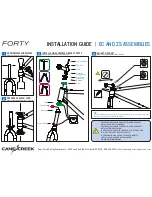
25
front braking force. This is even more important on descents,
because descents shift weight forward.
Two keys to effective speed control and safe stopping are
controlling wheel lockup and weight transfer. This weight transfer is
even more pronounced if your bike has a front suspension fork.
Front suspension “dips” under braking, increasing the weight
transfer (see also Section 4.F). Practice braking and weight
transfer techniques where there is no traffic or other hazards and
distractions.
Everything changes when you ride on loose surfaces or in wet
weather. Tire adhesion is reduced, so the wheels have less
cornering and braking traction and can lock up with less brake
force. Moisture or dirt on the brake pads reduces their ability to
grip. The way to maintain control on loose or wet surfaces is to go
more slowly to begin with.
D. Shifting gears
Your multi-speed bicycle will have a derailleur
drivetrain (see 2. below), an internal gear hub drivetrain (see 3.
below) or, in some special cases, a combination of the two.
1. How a derailleur drivetrain works
If your bicycle has a derailleur drivetrain, the gear-changing
mechanism will have:
• a rear cassette or freewheel sprocket cluster
• a rear derailleur
• usually a front derailleur
• one or two shifters
• one, two or three front sprockets called chainrings
• a drive chain
a.
Shifting Gears
The different types of shifters and their operation are
illustrated in figures 15 through 20. Identify the shifters on your bike
before reading on.
The vocabulary of shifting can be pretty confusing. A
downshift is a shift to a “slower” gear, one which is easier to pedal.
An upshift is a shift to a “faster”, harder to pedal gear. What’s
confusing is that what’s happening at the front derailleur is the
opposite of what’s happening at the rear derailleur (for details,
read the instructions on Shifting the Rear Derailleur and Shifting the
Front Derailleur below). For example, you can select a gear which
will make pedaling easier on a hill (make a downshift) in one of
two ways: shift the chain down the gear “steps” to a smaller gear
Fig. 15
Fig. 16
Fig. 17
Fig. 18
Fig. 19
Fig. 20










































